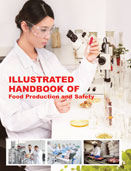Handbooks

This illustrated handbook delivers a wealth of information and provides a foundation for a practical understanding in food production and safety initiatives and safety guidelines. Ensuring safe food will be important for policymakers, food trade professionals, food producers, food processors, food researchers, public health professionals, and consumers. Most food is now produced by large farms, processed industrially, and sold in supermarkets and multinational food outlets. Modern food production has reduced the cost and increased the variety of food available, but this centralization of the food supply presents an opportunity for foodborne pathogens and toxins to infect and poison large numbers of consumers. Furthermore, the globalization of food trade means that food can become contaminated in one country and cause outbreaks of foodborne illness in another. Modern food production is so complex that a systematic approach is needed to identify the hazards at each point in the food chain. This handbook is designed to serve as a guideline for food manufacturers and includes the key areas necessary to control the safety, labelling and composition of food during manufacturing, processing, storage or distribution.
Food production is the procedure of renovating raw ingredients into prepared food products. Food production contains industries that take raw food products and transform them into marketable food items. Home food production consist of converting produce into forms for durable storage. Current trends in global food production, processing, distribution and preparation are creating an increasing demand for food safety in order to ensure a safer global food supply.
Illustrated Handbook of Food Production and Safety provides comprehensive coverage for a practical understanding in food production and safety initiatives and safety rules, how to deal with whole-chain traceability issues, and foodborne pathogens. Food safety is essential in protecting individuals from bacteria and parasites that can be passed through food consumption. By practicing safe food handling, illnesses and fatalities can be prevented. Safe food handling begins at production and continues through the preparation process. If unsafe handling has occurred at any stage, there could be a potential of danger. There have been times when contamination has taken place at the meat production and processing stage, and if contamination occurs during manufacturing, a consumer could inadvertently cook contaminated meat. Naturally occurring toxicants pose a relatively low risk to health in developed countries because effective food processing and a varied diet decreases exposure. Food processing is essential to feed a large urban population: it destroys naturally occurring toxicants and inhibits the growth and spread of pathogenic and spoilage organisms. Raw or unpasteurized milk and eggs are an important cause of food poisoning. In processed foods, food additives act as preservatives and processing aids and replace the color and nutrients lost during processing. The safety and use of food additives is strictly controlled by legislation. Food handling safety is just as important at the consumer level because many consumers have contaminated food through a lack of awareness. By practicing hygiene prior to handling food and ensuring that all utensils and surfaces are clean, food contamination can be prevented. Control of food safety and quality encompasses a broad number of factors, and governments must carefully select the areas in which they will set standards. In particular, quality includes attributes of food that are market concerns rather than public health matters. Governments should focus their attention and resources on the public health aspects of quality and on those market-related aspects of quality and labelling that will protect consumers against fraud and misleading claims. Clearly, food control involves many difficult issues. Some of these are highly technical, while others are partly technological and partly political. The mutual goal should be to resolve these questions in a way that takes into account the needs of governments, consumers and industry. For governments, there is the need for enforceable standards that are convincing to both consumers and industry. For consumers, food control systems must provide meaningful protection against real and important hazards. Finally, industry needs standards that permit flexibility and efficiency in producing and marketing foods that will serve their customers - the world?s consumers.
Illustrated Handbook of Food Production and Safety explores the traditional approach to food safety and control. This Handbook is particularly useful for students and researchers in food processing, food technology, food biotechnology, and food safety and nutrition.